2.
GHANA
Exports to the EU half of those to African countries
Exports of primary products (poles and billet) were worth
Euro 30,175,011 in the period January-March 2011 as
compared to Euro 39,525,381 in January-March 2010
while trade in tertiary products totalled Euro 2,508,036
compared to Euro 2,995,959 in January-March 2010.
Secondary products contributed 88% or Euro 26,748,889
to earnings for the first quarter as compared to 85% in the
first quarter 2010.
Markets in Africa accounted for around 43% of the total
trade and in the first quarter and were worth Euro
13,024,276. The main African importers were the
ECOWAS countries, especially Nigeria, Senegal, Niger,
Gambia, Mali, Benin, Burkina Faso and Togo.
Exports to the EU are now around half the level of those to
African countries and for the first quarter 2011 were Euro
7,562,190. Key EU markets included Italy, France,
Germany, the United Kingdom, Belgium, Spain, Ireland
and Holland.
Markets in Asia such as India, Malaysia, Taiwan P.o.C,
China, Singapore and Thailand together contributed Euro
3,924,077 to total export earnings in the first quarter 2011.
The US market now accounts around 10 of Ghana¡¯s export
earnings and in the first quarter earnings were down on
those fro the first quarter 2010.
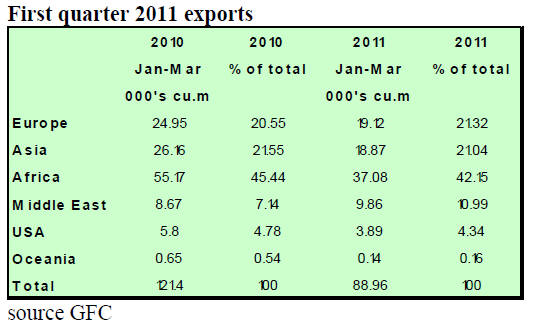
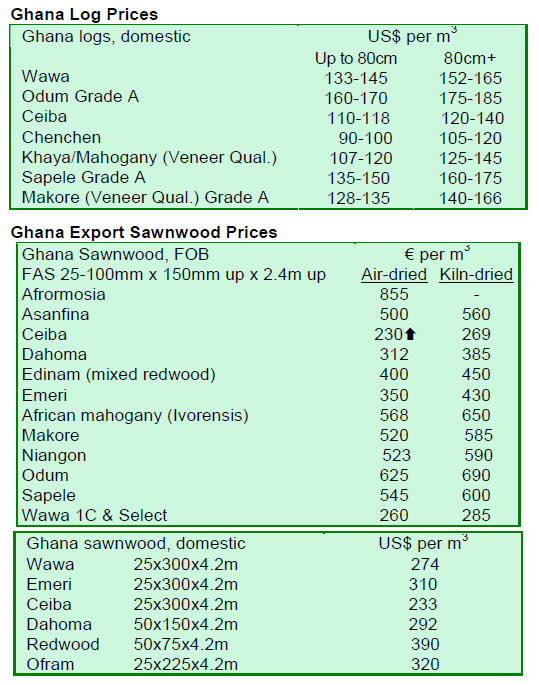
3.
MALAYSIA
Industry cautioned against expectations of
Japanese market demand
Analysts believe that Malaysian log and plywood prices
are set to rise substantially in response to demand for
reconstruction projects after the tragic earthquake and
subsequent tsunami in Japan.
In some cases just after the earthquake, plywood prices in
Japan rose between 30% to 50% especially among
plywood stockists and traders. Price increases among
plywood millers were more conservative.
However, some quarters have cautioned the timber
industry in Malaysia against speculating on the immediate
potential demand for logs and plywood from Japan.
Escalating fuel costs in Malaysia have made Malaysian
timber and timber products become the most expensive in
SE Asia.
Japanese government officials are still working on drafting
the first comprehensive blue-print for the reconstruction of
infrastructures and housing in Japan. It is likely that the
blue-print may only be released as late as October this
year. It is anticipated that Japan may source much of its
plywood needs from China and Indonesia.
Log availability affected by filling of Bakun dam
Log prices in Sarawak continue to rise as availability has
been affected by the ongoing flooding of the Bakun
hydroelectric dam.
Log production in Sarawak has fallen 23%, from 2.35
million cu.m in the first quarter 2010. Log export prices
are up by around 15% year on year.
In addition, exports of logs from Sarawak have also fallen
27%, from 1.07 million cu.m in the first quarter 2010 to
783,800 cu.m this year.
Sarawak shipped more than 51,800 cu.m of logs, valued at
RM28.7 million to Japan in the first quarter 2011, a drop
from the 81,400 cu.m shipped in the same period last
year. However, India remains Sarawak¡¯s largest log
importer, taking some 506,000 cu.m in the first quarter of
this year. This constitutes almost 65% of Sarawak¡¯s total
log exports.
Malaysia set to launch another international furniture show
Malaysia is set to launch another international furniture
show in September this year to draw visitors who may be
visiting other furniture shows around the Asian region
during that time, such as the ones in Shanghai and
Guangzhou.
The International Furniture Market exhibition is scheduled
to be held from September 6 to September 10, 2011, at the
Malaysian Agro Exposition Park.
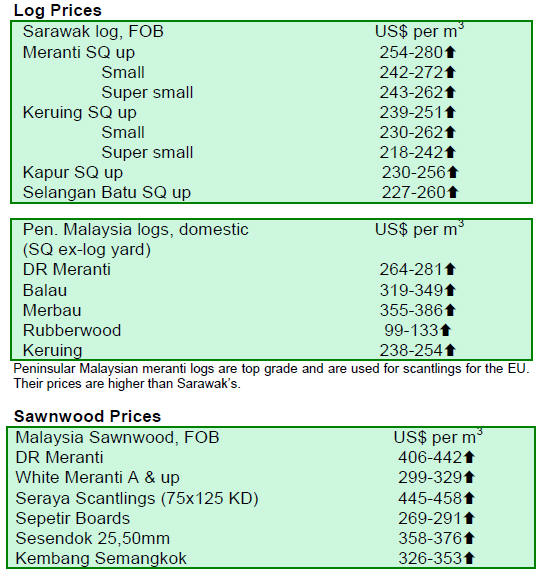
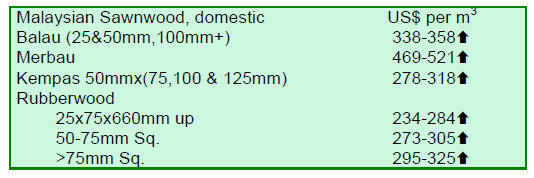
4.
INDONESIA
Indonesia to aid Japan at its time of need
Japan has sought help from Indonesia and other plywood
producing countries to meet its requirements for some 2
million sheets of plywood for reconstruction work in the
disaster hit areas.
It is reported that the Indonesian government is to
work
out a plan for shipping plywood at concessionary rates to
Japan. Japan is also seeking logs, sawnwood, laminated
timber products and other panel-products.
Indonesia is currently the second largest exporter of
timber
products to Japan after Malaysia. The other major exporter
is China. Indonesia¡¯s plywood exports to Japan in 2010
reached almost 932,000 cu.m.
The Indonesian government has a close relationship with
the Japanese government and is expected to assist the
country in its time of need. The Indonesian government
will reportedly meet to discuss the Japanese requirements
and is thought to be considering waiving any plywood
export taxes and tariffs.
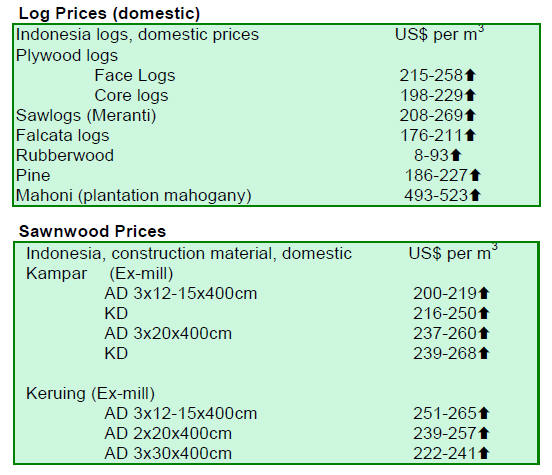
5.
MYANMAR
Market demand for teak and other hardwoods has
picked
up and overall the market is said to be good for round logs.
Logs versus processed wood exports discussed
A seminar on ¡°Emerging Market Requirements-
Challenges and Opportunities for Myanmar¡¯s Timber
Industry¡± was held recently in Myanmar, the key speaker
was Dato Dr. B.C.Y. Freezailah who spoke on the world
timber situation, illegal logging and emerging market
requirements.
He also spoke on legality and sustainability of timber,
EU
regulation, the US Lacey Act, and Pan ASEAN timber
certification initiative and various topics of interest to the
Myanmar wood industry.
U Barber Cho, Joint Secretary of the Myanmar Timber
Merchants Association also presented a paper on the
development of the Myanmar wood industry. He reported
on the state of the Myanmar timber industry, where he
discussed the availability of raw material and the pros and
cons of selling less in log form and more processed wood
products.
He made the point that neighbouring countries with
fewer
timber resources, such Malaysia and Vietnam, are earning
more revenue from wood products than Myanmar. He said
that Myanmar is rich in forest resources and stressed the
need for the country to learn from its neighbours.
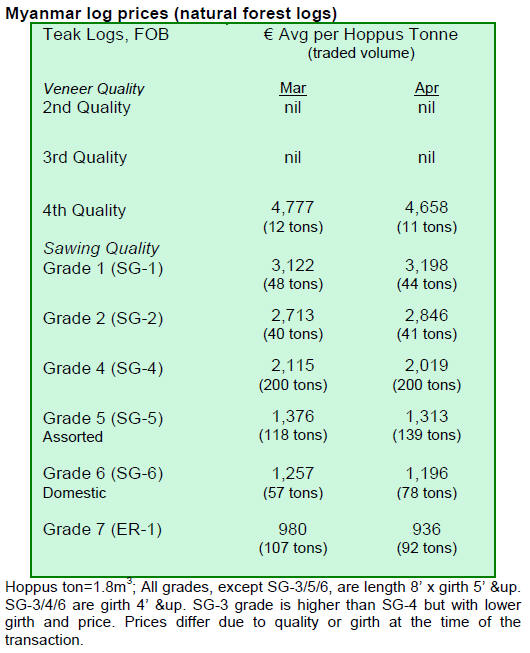
6. INDIA
Foreign investment directed to the
furniture sector
Foreign investment in the timber and furniture sectors has
been encouraged by the Indian government to meet the
growing demand for furniture and other timber products.
Initiatives have been taken to increase investment flows
into timber manufacturing.
The furniture sector in India makes a marginal
contribution to GDP, representing just a small percentage
(about 0.5%). In terms of size and technological
innovation, the office furniture segment has the more
important companies. The government of India has
specifically directed foreign investment in the timber
sector towards meeting the huge demand for office
furniture in the country.
Timber product manufacturing is one of the oldest
industries in India. Although traditionally a rural industry,
in recent years, the manufacturing of timber products has
developed to an industrial scale. The furniture industry in
India is considered as a "non organized" sector, with
handicraft production accounting for about 85% of the
furniture production in India.
Ambitious investment programme for Kolkata Port
The Kolkata Port, located on the banks of Hoogly river is
unique because most other ports in India are sea ports. The
Kolkata Port Trust manages two ports, Haldia's deep water
port and the oil piers of Baj Baj. Kolkata Port Trust,
formerly the Calcutta Port Trust oversees the shipping
system in Kolkata.
The Port Trust has embarked on an ambitious
investment
programme for development and expansion of the port in
order to handle increased trade. The plan is construct
multipurpose berths and jetties and improve support
facilities as well as the development of infrastructure to
augment existing road and rail connections. For more
information see
http://www.kolkataporttrust.gov.in/
Timber importers have drawn attention to the port
charges
at Kolkata port which they say are high compared to other
ports.
They point out that Kolkata Port is geographically
best
placed to handle timber imports from SE Asian countries
but that port charges discourage them from using this port.
In recent years Kolkata port handled only an amount
equal
to 20% of the timber imports through Kandla port.
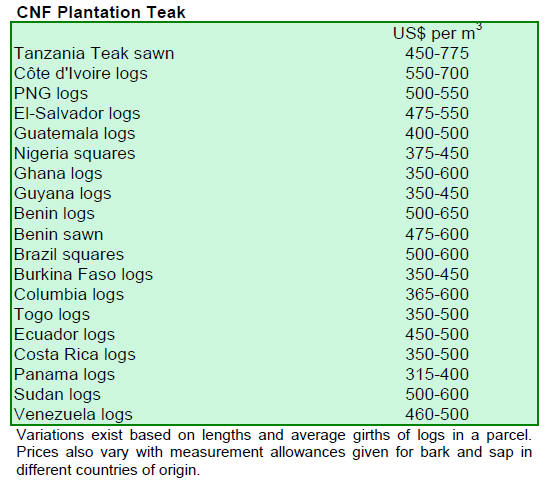
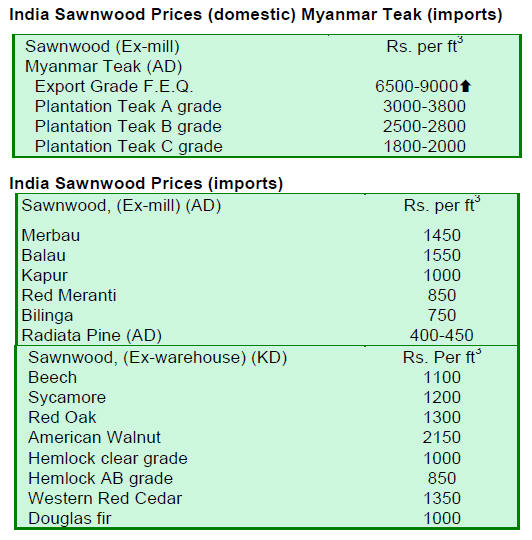
7. BRAZIL
First production of
sustainable timber
The first harvest of some 7,000 cu.m. of certified
sustainably produced wood has been made from a
concession in the Jamari National Forest, state of
Rondonia. This has generated close to BRL 700.000 (US$
422,120) according to the Brazilian Forest Service (SFB).
The SFB says this is the beginning of a process to
ensure
wood for the final consumer is from a forest managed in a
manner to guarantee land tenure security, legal security
and compliance with SFB environmental criteria.
The harvested timbers include about 30 species of
which
Astronium lecointei (trade name tiger wood) accounted for
28% of the harvest.
This timber is largely used in furniture
manufacturing and
flooring. Other timbers included tauari (Brazilian oak) and
angelim-pedra used in furniture manufacturing and for
construction.
The forest concession totals 96,000 hectares and is
managed by three companies, Amata, Sakura and
Madeflona. The concessionaires have been encouraged to
explore a range of different species so as to benefit from a
reduction in taxes paid to the government. The tax relief
only applies if a minimum volume ofspecific species are
harvested.
The Forest Service is making efforts to promote the
introduction of less familiar timber species in the market.
Timber sector expands formal employment levels
The timber industry in Par¨¢ State is a major sector and has
been generating both permanent and part-time
employment opportunities mainly, say analysts, due to an
increase in the number of companies that have adopted
sustainable forest management operations.
Employment growth in the timber industry has, for
some
years now, been below government expectations even
though the sector has expanded output. In 2010, formal
employment in Para¡¯s timber industry grew significantly
according to the Inter-Union Department of Statistics and
Socio-Economic Studies.
During the year the sawmilling sector generated 444
permanent jobs while the veneer manufacturing sector
created some 144 fulltime jobs. Other industries, such as
joinery/carpentry manufacturers, wooden artifact
manufacturers and cork and straw artifacts producers
generated another 80 jobs.
Par¨¢ only state to expand exports in 2010
Par¨¢ state, in the Amazon, is the main producer of tropical
timber in Brazil. Timber exports from the state grew in
2010 in sharp contrast to the export levels from other
states in the Amazon.
According to the Association of Timber Exporters of
Par¨¢
State (AIMEX), there was a rise of almost 12% in the
export of industrial timber products in 2010 compared to
2009. This was due, says AIMEX, to the economic turnaround
in the United States and European Union.
However, AIMEX warns that the prospects for 2011
are
not as positive since the growth rates seen in 2010 were
not maintained in the first 4 months of this year. From
January to April 2011, there was a 15% decline in the
value of exports and 19% drop in export volumes.
SINDUSMAD seeks waterway to facilitate exports
The Timber Industry Union of Northern Mato Grosso
(SINDUSMAD) is lobbying hard to have the hydroelectric
power plant planned for the Teles Pires river build locks to
allow timber to be transported by river. The timber
industry as a whole supports the establishment of a
waterway linking the northern region to the Port in Par¨¢.
The strength of the Northern Mato Grosso regional
economy is forest and timber based and in 2010 over 5
million cu.m of logs from sustainable forest management
operations were traded.
The timber industry in the region accounts for 38%
of the
Transport and Housing Fund (FETHAB) revenues in the
state. At the national level, state output corresponds to 4%
of GDP.
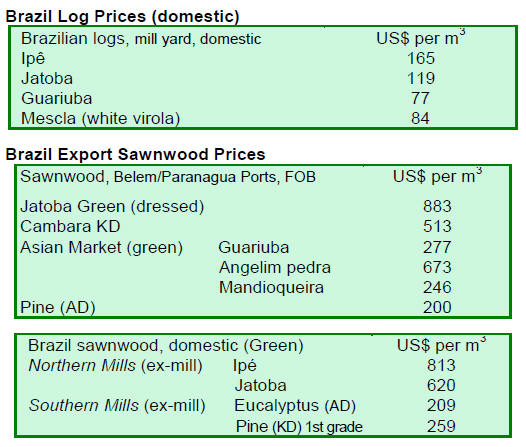
8. PERU
Timber exports fall 11% in first
quarter
Due to subdued demand for timber from Peru in
international markets and the lack of effective policies on
forest concessions, Peruvian wood product exports fell
11% in the first quarter of 2011 says the Association of
Exporters (Adex).
According to preliminary figures from Adex, timber
sales
were valued at US$31.7 million in the first quarter of 2011
compared to US$35.4 million the same period last year.
But, the situation is even worse when 2011 first quarter
exports are compared with those in the same period in
2008 (US$54.9 million). The main products affected were
semi-manufactured goods, lumber and minor product
exports.
Exports of semi-manufactured products were valued
at
US$12.8 million compared to the US$16.8 million level
for the first quarter in 2010. Lumber exports fell from
11.1 million in 2010 to 8.7 million between January and
March 2011.
On the other hand, fibreboard and particleboard
exports
grew significantly from the US$355,000 in the first quarter
2010 to US$1 million in the same period this year.
Adex, reports that the export figures reflect the
status of
some markets for Peruvian timbers such as China which,
up until March, had not resumed purchasing after the
Chinese New Year holiday. Despite having reduced its
purchases by 41 percent, China remains the largest
importer of Peruvian wood followed by Mexico and the
US.
Legal framework required for industry revival
Adex has pointed out that since last year some production
capacity had been lost due to, what the industry considers
as, constraints imposed on concession holders and
producers by regional governments.
This, says Adex, is mainly because the authorities
have not
approved submitted management plans.
Adex also identified the lack of a supportive
infrastructure
in regional administrations to the point that entrepreneurs
decide to no longer pursue timber related businesses. Adex
indicated that for the industry to operate effectively an
adequate legal framework is required and urged that the
Congress approve the Forestry Law.
The United States is reportedly anxious to see the
Congress of Peru adopt the new forest law as soon as
possible so that the free trade agreement between the two
countries can come into force. It has been reported that the
Congress will continue debate of the forest law during the
first week of June.
Gold rush damages Peruvian Amazon
Deforestation in the Peruvian Amazon has increased in
recent years due to incursions by informal miners driven
by high gold prices.
This information came from a study released in May
by
Duke University. The study reports that in the eastern
department of Madre de Dios, some 7,000 hectares of
virgin forest and wetlands have been destroyed by mining.
The research combines NASA satellite imagery of
Madre
de Dios between 2003 and 2009, economic analysis of the
gold price and imports of mercury which is used in
separating gold. The head of the research team apparently
reported that mining areas in Peru are now clearly visible
from space. For more information see
http://today.duke.edu/2011/04/goldperu
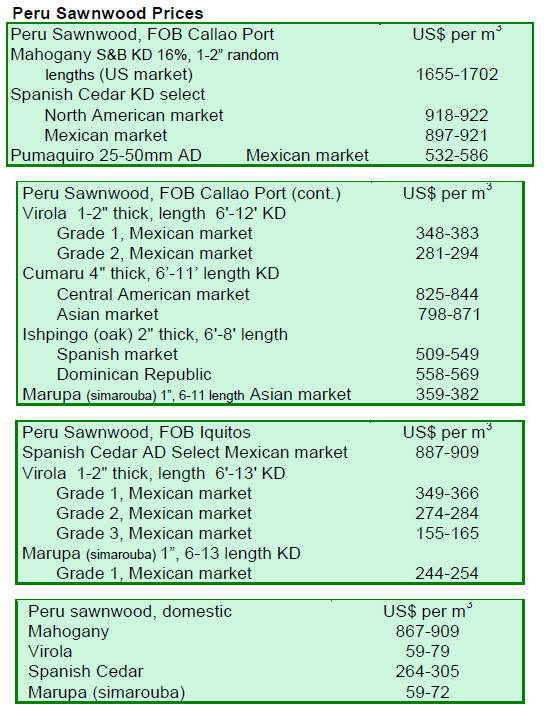
9.
GUYANA
General upswing in prices
During the period under review there were no exports of
greenheart logs. Purpleheart logs continued to attract
increased prices for all sawmill log grades. Mora log
prices increased for standard and fair sawmill quality,
while prices for small sawmill quality remained
unchanged.
Undressed greenheart (select) prices have decline,
notably
at the top of the range and are now at US$806 in
comparison to prices two weeks earlier. For undressed
purpleheart there were some exports and accompanying
price changes for three of the sawmill qualities namely
select, sound and merchantable, these qualities fetched
higher prices. Undressed mora (select) also attracted
moderately higher prices.
Top end prices for dressed greenheart prices fell
from
US$1,011 to US$785 for this fortnight period as compared
to the previous period. However dressed purpleheart
continues to attract good export prices, with a strong
upswing in prices at the top of the range from US$1,060 to
US$1,302.
Some of Guyana¡¯s lesser used species have made
headway
in the Caribbean, European and USA sawnwood markets
and secured better prices than seen recently.
Prices for Guyana¡¯s ipe (washiba) rose reaching
US$2,350
per cubic metre. Demand for ipe is high in the North
American market. For roundwood, (greenheart Piles) were
well received in the European and North American market
attracting good prices along with (wallaba poles) for
which prices also improved.
The leading added value product exported recently
was
outdoor garden furniture for the UK market. Prices
increased for sustainably sourced outdoor furniture
utilizing Guyana¡¯s locust (jotaba). Other value added
product exports included doors and window frames.
Guyana launches UN ¡®Year of Forests¡¯
Guyana recently held a commemorative launch for the
United Nations¡¯ International Year of Forests.
In keeping with the long term goals of the Low
Carbon
Development Strategy, the Government of Guyana,
through its entities the Ministry of Agriculture and the
Guyana Forestry Commission, recognizes the importance
of reinforcing established policies on the use of forests
with particular reference to sustainable forest management
and its contribution to economic development and poverty
eradication.

Related News:
¡¡